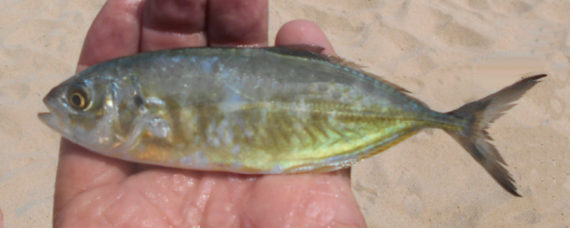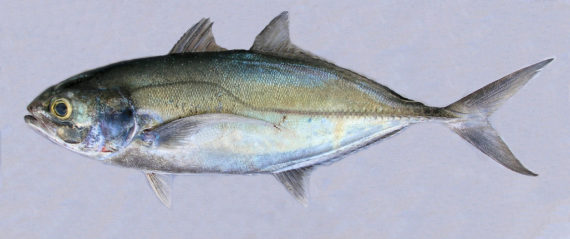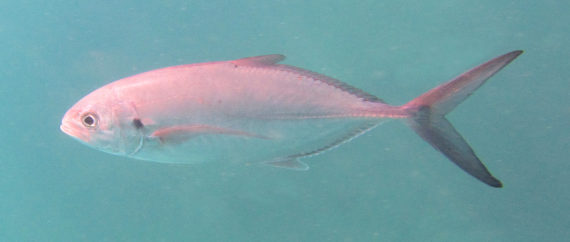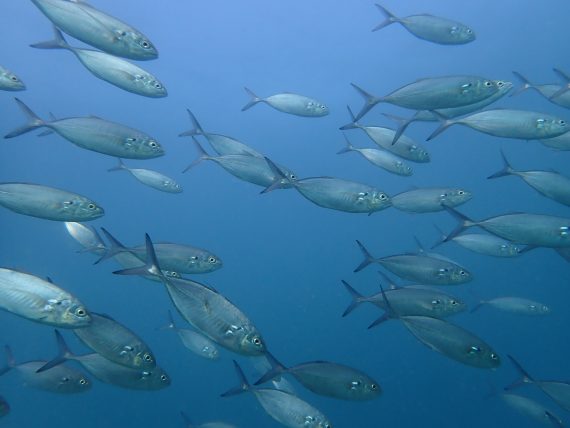Green Jack, Caranx caballus
 Green Jack, Caranx caballus, Juvenile. Caught with a cast net by commercial bait salesmen in the greater Los Cabos area, Baja California Sur, October 2019. Length: 14 cm (5.5 inches).
Green Jack, Caranx caballus, Juvenile. Caught with a cast net by commercial bait salesmen in the greater Los Cabos area, Baja California Sur, October 2019. Length: 14 cm (5.5 inches).
 Green Jack, Caranx caballus. Fish caught from coastal waters off Mazatlán, Sinaloa, October 2021. Length: 30 cm (12 inches). Catch, photograph and identification courtesy of Bart, The Netherlands (worldangler.eu).
Green Jack, Caranx caballus. Fish caught from coastal waters off Mazatlán, Sinaloa, October 2021. Length: 30 cm (12 inches). Catch, photograph and identification courtesy of Bart, The Netherlands (worldangler.eu).
 Green Jack, Caranx caballus. Caught off the beach in the greater Los Cabos area, Baja California Sur, November 2010. Length: 34 cm (13 inches).
Green Jack, Caranx caballus. Caught off the beach in the greater Los Cabos area, Baja California Sur, November 2010. Length: 34 cm (13 inches).
 Green Jack, Caranx caballus. Underwater photograph taken in coastal waters of the greater Los Cabos area, Baja California Sur, May 2018. Photograph courtesy of Bob Hillis, Ivins, Utah.
Green Jack, Caranx caballus. Underwater photograph taken in coastal waters of the greater Los Cabos area, Baja California Sur, May 2018. Photograph courtesy of Bob Hillis, Ivins, Utah.
 Green Jacks, Caranx caballus. Underwater photograph taken in Zihuantanejo Bay, Guerrero, January 2020. Photograph and identification courtesy of Maude Jette, Dive Zihuantanejo, www.Divezihuatanejo.com.
Green Jacks, Caranx caballus. Underwater photograph taken in Zihuantanejo Bay, Guerrero, January 2020. Photograph and identification courtesy of Maude Jette, Dive Zihuantanejo, www.Divezihuatanejo.com.
The Green Jack, Caranx caballus, is a member of the Jack or Carangidae Family, and is known in Mexico as cocinero and jurel bonito. Globally, there are seventeen species in the genus Caranx, of which nine are found in Mexican waters, three in the Atlantic and five in the Pacific and one in both the Atlantic and Pacific Oceans.
The Green Jack has a moderately compressed relatively slender rectangular body with a depth that is 26% to 30% of standard length. They are overall light olive to dark blue-green with a silvery to golden coloration ventrally. They have seven pale narrow vertical bars spaced about 1 inch apart along their sides that fade quickly upon collection. Their head profile is convex and gently sloping with a blunt snout and fairly large eyes set just above the mid-line. Their mouth is small and opens at the front. Their gill cover has a black spot located halfway between the pectoral fin base and the end of the lateral line. All their fins are pale. Their anal fin has 2 standalone spines followed by 1 spine and 18 to 21 rays; their caudal fin has a slender base and is deeply forked; their first dorsal fin has 8 spines; their second dorsal fin has 1 spine and 22 to 25 rays; and, their pectoral fins are exceedingly long being greater than the head. The dorsal fins are of equal size. They have 28 to 30 gill rakers. Their lateral lines is pronounced with a short anterior arch with 45 to 56 strong prominent scutes.
The Green Jack is a common pelagic schooling species found over all types of terrain at depths up to 100 m (330 feet). Occasionally be seen on the surface traveling in large schools and bait balls. They reach a maximum of 75 cm (2 feet 6 inches) in length. As of January 1, 2024, the International Game Fish Association world record stood at 2.81 kg (6 lbs 3 oz) with the fish caught from coastal waters off Cabo San Lucas, Baja California Sur, in May 2000. The Green Jack is poorly studied with very limited information available about their lifestyle and behavioral patterns including specific details on age, growth, longevity, movement patterns, diet, habitat use, and reproduction.
The Green Jack is a resident of all Mexican waters of the Pacific Ocean.
The Green Jack is identical in appearance and morphology to the Blue Runner, Caranx crysos (Atlantic Ocean only, 35 to 42 gill rakers). In the Pacific, the Green Jack is most likely confused with the Bigeye Trevally, Caranx sexfasciatus (large eye; smaller black spot high on gill cover) and the Cocinero, Caranx vinctus (dark bars on sides; yellow fins).
From a conservation perspective the Green Jack is currently considered to be of Least Concern with stable, widely distributed populations. As certain times of the year and in certain locations they will show up in abundance in shallow water coastal environments. They can be caught off the beach and are considered an insignificant catch. Local fishermen do not view them as quality live bait. They are considered marginal table fare and normally a “catch and release” by all but subsistence fishermen.